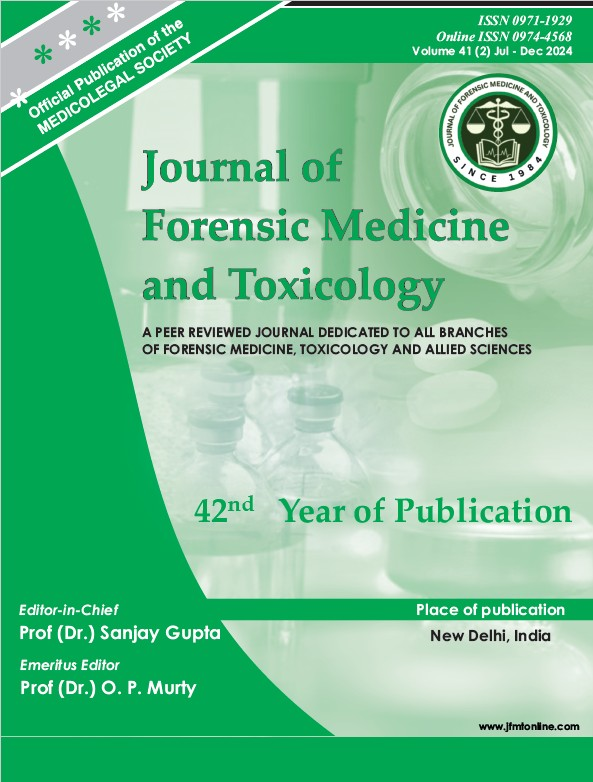AUTOPSY-BASED STUDY FOR DETERMINATION AND EVALUATION OF AGE ESTIMATION THROUGH MACROSCOPIC EXAMINATION OF CRANIAL SUTURE CLOSURE BY ECTOCRANIAL METHOD AT MORTUARY COMPLEX OF SAURASHTRA REGION
DOI:
https://doi.org/10.48165/jfmt.2024.41.1.8Keywords:
Ectocranial, cranial suture, Sagittal, Coronal, lambdoid.Abstract
Introduction: The lack of existing data pertaining to the Bhavnagar region, coupled with the inability to extrapolate findings from prior investigations, prompted the initiation of the present study. The primary objectives of this research were to elucidate the temporal progression of suture closure, ascertain sexual dimorphism, and evaluate the accuracy of age determination methods specific to the Bhavnagar region Materials and Methodology: A total of 100 cases of >20 years of age brought for medicolegal autopsy were analyzed. The coronal, sagittal, and lambdoid sutures were studied ectocranially. The degree of obliteration of sutures was scored ectocranially. Data were analyzed using Epi-info7 Software. Descriptive statistics were evaluated for continuous data, and categorical data were presented by frequency and percentages. An independent t-test was applied to find out the mean difference between the right and left sides of suture closure for ectocranial surfaces. Result: Regarding the chronology of suture closure, the present study found some variations compared to previous research. Notably, in the Sagittal suture, the anterior 1/ 3rd segment closed earlier in males, potentially due to lapsed union. Similarly, in the Coronal suture, the C1 segment closed first, followed by C2 and C3 in both genders. For the Lambdoid suture, L3 closed earlier than L2 and L1 in females, while L1 closed first in males. Conclusion: The present research highlights variations in gender and surface-based closure patterns. The erratic nature of suture obliteration necessitates caution when using it as the sole method for age estimation in forensic contexts.
Downloads
References
Kalsi G, Singh A, Harish D: Macroscopic study of temporoparietal suture closure at autopsy for estimation of age. J Clin Diagnostic Res. 2022, 16:1-4. 10.7860/JCDR/2022/50232.15845
Reddy KS, Murty OP: The Essentials of Forensic Medicine and Toxicology . Reddy KS, Murty OP (ed): Jaypee Brothers Medical Publishers (P) Ltd, New Delhi; 2017.
Modi JP, Kannan K: A Textbook of Medical Jurisprudence and Toxicology . Modi JP, Kannan K (ed): Lexis Nexis Butterworths, Gurgaon; 2016.
Anderson MF, Anderson DT, Wescott DJ: Estimation of adult skeletal age-at-death using the Sugeno fuzzy integral. Am J Phys Anthropol. 2010, 142:30-41. 10.1002/ajpa.21190
Baccino E, Ubelaker DH, Hayek LA, Zerilli A. Evaluation of seven methods of estimating age at death from mature human skeletal remains. J Forensic Sci. 1999;44:931–6.
Buckberry JL, Chamberlain AT. Age estimation from the auricular surface of the ilium: a revised method. Am J Phys Anthropol. 2002;119:231–9.
Rissech C, Wilson J, Winburn AP, Turbón D, Steadman D. A comparison of three established age estimation methods on an adult Spanish sample. Int J Legal Med. 2012;126:145–55.
Acsadi G, Nemeskeri J. History of Human lifespan and mortality. Budapest: Akademiai Kiada; 1970. 346 p.
Meindl RS, Lovejoy CO. Ectocranial suture closure: a revised method for the determination of skeletal age
at death based on the lateral-anterior sutures. Am J Phys Anthropol. 1985;68:57–66.
Singer R. Estimation of age from cranial suture closure. A report on its unreliability. J Foren Med (S Afr). 1953;1:52–9.
Masset C. Age estimation on the basis of cranial sutures. In: Iscan M, editor. Age markers in the human skeleton. Springfield: Charles C. Thomas; 1989. p. 71– 103.
Hershkovitz I, Latimer B, Dutour O, Jellema LM, Wish-Baratz S, Rothschild C, et al. Why do we fail in aging the skull from the sagittal suture? Am J Phys Anthropol. 1997;103:393–9.
Kirk J. Cranial suture closure: a quantitative method for age estimation using laser instrumentation. Southern Nazarene University; 2003.
Chiba F, Makino Y, Motomura A, Inokuchi G, Torimitsu S, Ishii N, et al. Age estimation by multidetector CT images of the sagittal suture. Int J Legal Med. 2013;127:1005–11.
Acsadi G, Nemeskeri J. History of human life span and mortality.Budapest: Akademiai Kiado,1970.
Shetty U. Macroscopic study of cranial suture closure at autopsy for estimation of age (thesis submitted to the university of Delhi,2008, for MD in Forensic Medicine and Toxicology,2009; Volume 10, Number 2,(July-December2009)available at http:// www.geradts.com/anil/ij/vol 010 no 002/other/thesis/ ullas_thesis.pdf.
S.M.Hepworth.On determination of age in Indian: Study of ossification of the epiphysis of the long bones.Ind.Med. Gaz.1929;64:128.
G.Galstaun. Some notes on the union of epiphyses in Indian girls. Ind.Med.Gaz.1930;65:191-192.
G.Galstaun. A study of ossification as observed in Indian subjects.Ind.J.Med.Res.19937;25:267-324.
R.Lall, B.S. Nat. Ages of epiphyseal union at the elbow and wrist joints amongst Indians. Ind. J. Med. Res. 1934;21:683-689.
D. Narayan, I. D. Bajaj. Ages of epiphyseal union in long bones of inferior exremity in U.P.Subjects. Ind. J. Med. Res.1957:45:645-649.
I. D. Bajaj, O.P. Bhardwaj, S.Bhardwaj. Appearance and fusion of important ossification centers: A study in Delhi population. Ind. J. Med. Res.1967;55;1064- 1067.
M.J.S.Pillai. The study of epiphyseal union for determination the age of south Indians. Ind. J. Med. Res.1936;23:1015-1017.
Mc kern TW, Stewart TD. Skeletal age changes in young American males: Environmental protection
Research Division, Technical Report EP-45, Headquarters Quartermaster Research and Development Command, Natrick MA.1957; P.26-28.
Krogman WN, Iscan MY. Skeletal age: In : The human Skeleton in Forensic Medicine.Charles C Thomas Publishers 1986; 2nd edn: P.103-132.
F.E.Johaston.Sequence of epiphyseal union in prehistoric Kentucky population.Indian Knoll. Hum. Biol. 1961;33:66-81.
Parsons FG, Box CR. The relation of cranial suture to age, Journal of the Royal Anthropology Institute.1905,35:308.
T. W. Todd, D.W. Lyon jr. Suture closure-Its progress and age relationship part 4. Endocranial closure in Adult males of Negro stock. Am. J. Phys. Anthropol.1925;8:149-168.
Cobb. W.M. Skeleton in. A.I. lansing (Ed). Cowdry’s problem of ageing, biological and medical aspects. Williams and Wilkins, Baltimore. 1952; P.804.
Perizonius WRK. Closing and non-closing sutures in 256 crania of known age and sex from Amsterdam (A.D. 1883-1909). Journal of human Evolution.1984;13:201-216.
T. D. Stewart. Sequence of epiphyseal union suture closure in Eskimo and American Indians. Am. J. Phys. Anthropol.1934;19:433-452.
Singer R. Estimation of age from cranial suture closure. A report of its unreliability. J. Foren. Med. (S.Afr)1953;1:52-59.
Power R. The disparity between known age and age as estimated by cranial suture closure. Man 1962; 62:52-54.




